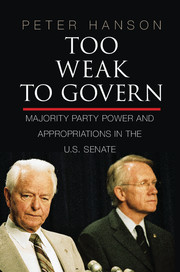5 - The Second Wave (1995–2012)
Published online by Cambridge University Press: 05 November 2014
Summary
Infighting within the Republican Senate majority during the 1980s helped to transform temporary continuing resolutions (CRs) into yearlong measures to fund the federal government. The first wave of omnibus appropriating continued until 1988, when Congress returned to passing appropriations bills on an individual basis. The period of regular order ended with the Republican takeover of Congress in 1995, and omnibus bills again were routinely used by Congress to fund the government. In Chapter 5, I investigate the second wave of omnibus appropriating with a study of the administration of President George W. Bush from 2001 to 2004.
Evidence from this era fits in major respects with the expectations of the limited influence theory. The Senate majority party was weak because of extraordinarily narrow margins of control. The chamber was so closely divided that control over it shifted twice in two years. Each party also had a handful of moderates whose votes could be won by the other side. The risk of defection meant the majority risked being embarrassed or rolled in key votes by the minority when it brought the bills to the floor. The rising ideological gulf between Republicans and Democrats also intensified minority opposition to legislation and raised the risk of disruptive filibusters. These problems made it difficult and politically dangerous for the majority to pass spending bills on an individual basis. Abandoning the regular order helped the majority party to overcome these problems by shielding it from tough votes and ensuring passage of the budget.
- Type
- Chapter
- Information
- Too Weak to GovernMajority Party Power and Appropriations in the U.S. Senate, pp. 131 - 159Publisher: Cambridge University PressPrint publication year: 2014



